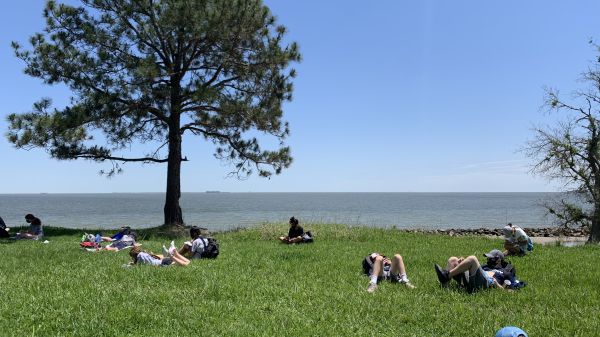Coastal Perspectives in EE: Galveston Bay Foundation

By: Kara Nunnally, eeRESEARCH Library Associate, Duke University Nicholas School of the Environment
This post is part of a series on EE practices for coastal resilience in the United States. In collaboration with NAAEE, Duke University is showcasing EE practices and advice from organizations on each coast while highlighting relevant research to help EE practitioners learn from academic literature.
In the midst of a nearby and severe hurricane, Cindy Wilems, Director of Education at Galveston Bay Foundation, took the time to speak with me about their EE initiatives and the ways they are building a community of coastal resilience in the face of climate change (and stronger storms!).
Located in Kemah, Texas, Galveston Bay Foundation (GBF) was founded in 1987 to “preserve and enhance Galveston Bay as a healthy and productive place for generations to come…through creative, inclusive, and forward-thinking solutions to the challenges confronting Galveston Bay.” The organization serves the entire Bay area, and their presence extends to the barrier islands and as far inland as Houston. Their focus areas include education, habitat restoration, water protection, land conservation, research, and advocacy.
“EE is difficult. A lot of people think ‘oh, you just take kids outside and have fun with them all day’ but there are so many components we’re trying to merge and blend to do it the right way – it’s a challenge. But I look forward to it every day.” —Cindy Wilems
GBF hosts camp experiences, service-learning events, and field projects. They also offer virtual field trips, and they go into local schools for workshops and lessons. Being present in classrooms and bringing the Bay directly to students and teachers is just as impactful and important as getting students and teachers in the field. For example, GBF hosts an Engineering Shorelines workshop and provides materials like bins, sand, and water for students to engineer their own shorelines in local classrooms. They then choose to build their shorelines with bulkheads or living shoreline materials (marsh grasses and oysters), and test their model against waves. Ultimately, this experience allows students to witness erosion and get hands-on experience in problem-solving for sea-level rise.

Another workshop asks students to review a Galveston Bay report card that “grades” the Bay on different parameters like habitat, water quality, and human impacts. The students identify something they would like to save and create an action plan on how they can realistically improve the “grade” for that parameter. This illuminates ways students can collectively and individually act to impact their local environment. A great example is when a group of students identified pet waste as a pressing water quality issue. Not only did their action plan include making available compostable doggie bags at their local park with an informational sign, but also they wrote to the Houston Chronicle newspaper about the issue and their solution. This level of ownership is a key pillar of their work. “I have a belief that we can’t ask young kids too early to try to save the world because they don’t love it yet. If they don’t love their place, they won’t continue helping the environment after you leave them. So for our programs, especially in elementary programs, we want them to experience the Bay and give them a sense of wonder. Then we incorporate more of the ownership and action items as they grow through their educational career,” Wilems commented.
“I have a belief that we can’t ask young kids too early to try to save the world because they don’t love it yet. If they don’t love their place, they won’t continue helping the environment after you leave them. So for our programs, especially in elementary programs, we want them to experience the Bay and give them a sense of wonder. Then we incorporate more of the ownership and action items as they grow through their educational career.” —Cindy Wilems
For GBF, service-learning and EE merge in a variety of projects including planting marsh grass and collecting marine debris along the shoreline. A newer program centers on building oyster reefs and GBF takes students to the site to monitor the growth of new oysters and collect and identify other organisms with seine nets that live around the reef. After a visit to the oyster reef, students dissect an oyster to gain a better understanding of the science behind oysters and their importance in coastal ecosystems. This program ties into science lessons that teachers teach in classrooms. GBF provides a list of things teachers can do to complement what students observe in the field and demonstrate the importance of coastal resilience.

Wilems shared how important reflection and evaluation aspects are to EE at GBF. “We have to meet them [students and teachers] where they are. First, we have to make them feel safe. Then they can learn and experience new things. If they don’t feel safe and understood first, how can we think about them helping the environment?” Students reflect at the end of each field event through a loose version of nature journaling which can result in writings, poems, illustrations, and more. Drawing activities can also assess student learning in a fun, nontraditional way. Taking time to reflect provides space for the students to sit quietly and digest the day, helping students develop their connection with the local environment. Similarly, GBF asks teachers to complete an online evaluation form after their programming to gain insight into the experiences of both the students and the teachers during and after their EE programs. The data from these evaluations are analyzed monthly by GBF, and these insights help the organization better design and implement materials that support and enhance learning and create safe spaces for students to learn.
“EE is difficult. A lot of people think ‘oh, you just take kids outside and have fun with them all day’ but there are so many components we’re trying to merge and blend to do it the right way—it’s a challenge. But I look forward to it every day,” Wilems said. It’s a balancing act of meeting state educational standards for teachers but also making the experience fun for students. If students have an amazing experience, they’re more likely to connect with nature, help the environment, and potentially pursue an environmental career. In the face of the menagerie of EE components and priorities, GBF is creating a more resilient future by meeting students and teachers where they are and creating safe spaces to learn.
Summaries Cited:
Barrera-Hernández, L. F., Sotelo-Castillo, M. A., Echeverría-Castro, S. B., & Tapia-Fonllem, C. O.. (2020). Connectedness to nature: Its impact on sustainable behaviors and happiness in children. Frontiers in Psychology, 11. doi:http://dx.doi.org/10.3389/fpsyg.2020.00276
Boyd, D. (2019). Utilising place-based learning through local contexts to develop agents of change in Early Childhood Education for Sustainability. Education 3-13, 47(8), 983-997. doi:http://dx.doi.org/10.1080/03004279.2018.1551413
Dentzau, M. W., & Martínez, A. José Gall. (2016). The development and validation of an alternative assessment to measure changes in understanding of the longleaf pine ecosystem. Environmental Education Research, 22(1), 129 - 152. presented at the 2016/01/02/. Retrieved from http://dx.doi.org/10.1080/13504622.2014.930728
Mackay, C. M. L., & Schmitt, M. T.. (2019). Do people who feel connected to nature do more to protect it? A meta-analysis. Journal of Environmental Psychology, 65. http://dx.doi.org/10.1016/j.jenvp.2019.101323
Moseley, C., Summerford, H., Paschke, M., Parks, C., & Utley, J. (2020). Road to collaboration: Experiential learning theory as a framework for environmental education program development. Applied Environmental Education & Communication, 19(3), 238–258. https://doi.org/10.1080/1533015X.2019.1582375
NAAEE. (n.d.) eeLEARN: Research and evaluation. https://naaee.org/eepro/learning/eelearn/research-evaluation
NAAEE. (n.d.) eeVAL: AWE Reflection Question. https://evaluation.naaee.org/tools/awe-reflection-question
Raatikainen, K. J., Juhola, K., Huhmarniemi, M., & Peña-Lagos, H.. (2020). "Face the cow": Reconnecting to nature and increasing capacities for pro-environmental agency. Ecosystems and People, 16(1), 273-289. doi:http://dx.doi.org/10.1080/26395916.2020.1817151
Trott, C. D. (2020). Children’s constructive climate change engagement: Empowering awareness, agency, and action. Environmental Education Research, 26(4), 532 - 554. presented at the 2020/04/02/. Retrieved from https://doi.org/10.1080/13504622.2019.1675594
Tsevreni, I. (2021). Nature journaling as a holistic pedagogical experience with the more-than-human world. The Journal of Environmental Education, 52(1), 14 - 24. presented at the 2021/01/02/. Retrieved from https://doi.org/10.1080/00958964.2020.1724854

